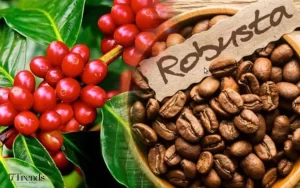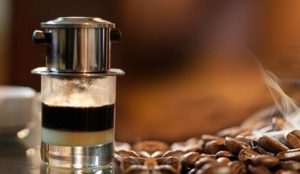Vietnamese coffee culture is a rich tapestry that blends tradition with modernity. It reflects the country’s history, social habits, and economic activities. Whether it’s the strong, slow-dripped coffee enjoyed on a bustling street corner or the innovative coffee drinks found in trendy urban cafes, Vietnamese coffee culture offers a unique and deeply ingrained experience for both locals and visitors.
I. History and Origins

- Coffee was introduced to Vietnam by the French in the 19th century. The fertile soil and favorable climate of the Central Highlands, particularly in areas like Buon Ma Thuot, proved ideal for coffee cultivation.
- Over time, Vietnam has become one of the largest coffee producers in the world, known especially for its robusta beans.
II. Types of Vietnamese Coffee
1. Cà phê sữa đá(Vietnamese iced milk coffee):
Iced coffee with sweetened condensed milk. This is one of the most popular ways to enjoy coffee in Vietnam, especially in the hot and humid climate.

2. Cà phê đen(black coffee):
Black coffee, which can be served hot or iced. It is typically made using a traditional drip coffee method and is known for its strong, bold flavor.
 3. Cà phê trứng(egg coffee):
3. Cà phê trứng(egg coffee):
Egg coffee, a Hanoi specialty, where egg yolk is whipped with sugar and coffee to create a creamy, rich drink.
 4. Cà phê phin(Vietnamese filtered coffee):
4. Cà phê phin(Vietnamese filtered coffee):
Coffee brewed using a traditional Vietnamese drip filter called a “phin.” This method produces a strong, concentrated coffee often enjoyed slowly.
 5. Cà phê muối(salt coffee):
5. Cà phê muối(salt coffee):
Salt coffee is a unique and distinctive coffee beverage in Vietnam that combines the rich flavors of coffee with a touch of salt to create a unique taste experience.

III. Café Culture-Vietnamese coffee culture
1. Street-side Cafes:
Known for their simplicity, with low plastic stools and tables set up on sidewalks. These cafes are places where people of all ages gather to socialize, people-watch, and enjoy their coffee.

Here are some popular street-side cafes across various cities in Vietnam that you shouldn’t miss:
- Cafe Giảng: 39 Nguyen Huu Huan, Hoan Kiem District, Hanoi
- Cong Caphe: Multiple locations, but the original is at 101 Hoang Cau, Dong Da District, Hanoi
- Saigon Coffee Roastery: 151B/5 Dong Khoi, Ben Nghe Ward, District 1, Ho Chi Minh city.
- La Pensée Café & Librairie: 27 Tran Quoc Toan, Hai Chau District, Da Nang
- Nook Cafe & Bar: 3A Le Loi, Vinh Ninh Ward, Hue
2. Train Street Cafe in Hanoi:
One of the most unique and exciting attractions in the city, offering visitors a thrilling experience of watching trains pass just inches away from residential buildings and cafes.

Several small cafes have sprung up along Train Street, offering drinks and snacks. These cafes often have seating that is pulled back when a train is approaching, adding to the excitement and charm of the experience. Popular cafes include Train Track Cafe, Railway Cafe, and Hanoi Train Street Cafe.
3. Modern Cafes:
In urban areas, trendy coffee shops with contemporary designs are popular among the younger generation. These cafes often offer a variety of coffee styles, including Western-inspired options like lattes and cappuccinos.

Here are some popular modern cafes in Vietnam:
- The Note Coffee: 64 Luong Van Can, Hoan Kiem District, Hanoi
- Tranquil Books & Coffee: 5 Nguyen Quang Bich, Hoan Kiem District, Hanoi
- The Coffee House: Multiple locations across the cities
- The Workshop: 27 Ngo Duc Ke, Ben Nghe Ward, District 1, Ho Chi Minh city
- Retro Kitchen and Bar: 85-87 Tran Phu, Hai Chau District, Da Nang
- The One Coffee & Bakery: 3A Le Loi, Vinh Ninh Ward, Hue.
IV. Social Aspect
- Unlike in some Western cultures where coffee is often consumed quickly on the go, Vietnamese coffee culture encourages a leisurely pace. People take their time to savor their coffee, read a newspaper, or enjoy conversations.
- Coffee drinking in Vietnam is a social activity. Friends, family, and colleagues often gather at cafes to chat, discuss business, or simply relax. This culture is evident in the popularity of both traditional street-side cafes and modern coffee shops.
V. Unique Practices
1. Slow Brewing: The phin filter method is a slow brewing process, encouraging a leisurely pace of life and allowing time for conversation and reflection.
 2. Blending with Local Flavors: In some regions, coffee is blended with local ingredients like coconut milk, yogurt, or even fruit to create unique flavor profiles.
2. Blending with Local Flavors: In some regions, coffee is blended with local ingredients like coconut milk, yogurt, or even fruit to create unique flavor profiles.

Tips for Enjoying Coffee in Vietnam:
- Try Local Specialties:Don’t miss out on trying unique drinks like egg coffee in Hanoi or coconut coffee in the south.
- Visit Different Types of Cafes:Experience both traditional street-side cafes and modern coffee shops to get a full sense of Vietnamese coffee culture.
- Be Prepared for Strong Coffee:Vietnamese coffee is often strong and bold, so be prepared for a different taste experience compared to lighter Western coffees.
- Enjoy the Atmosphere:Take your time to relax and soak in the atmosphere. Coffee drinking in Vietnam is as much about the experience as it is about the drink itself.
![]() Visa FOPA Company
Visa FOPA Company
📞+84 906 044 975 (Mr. Do)


